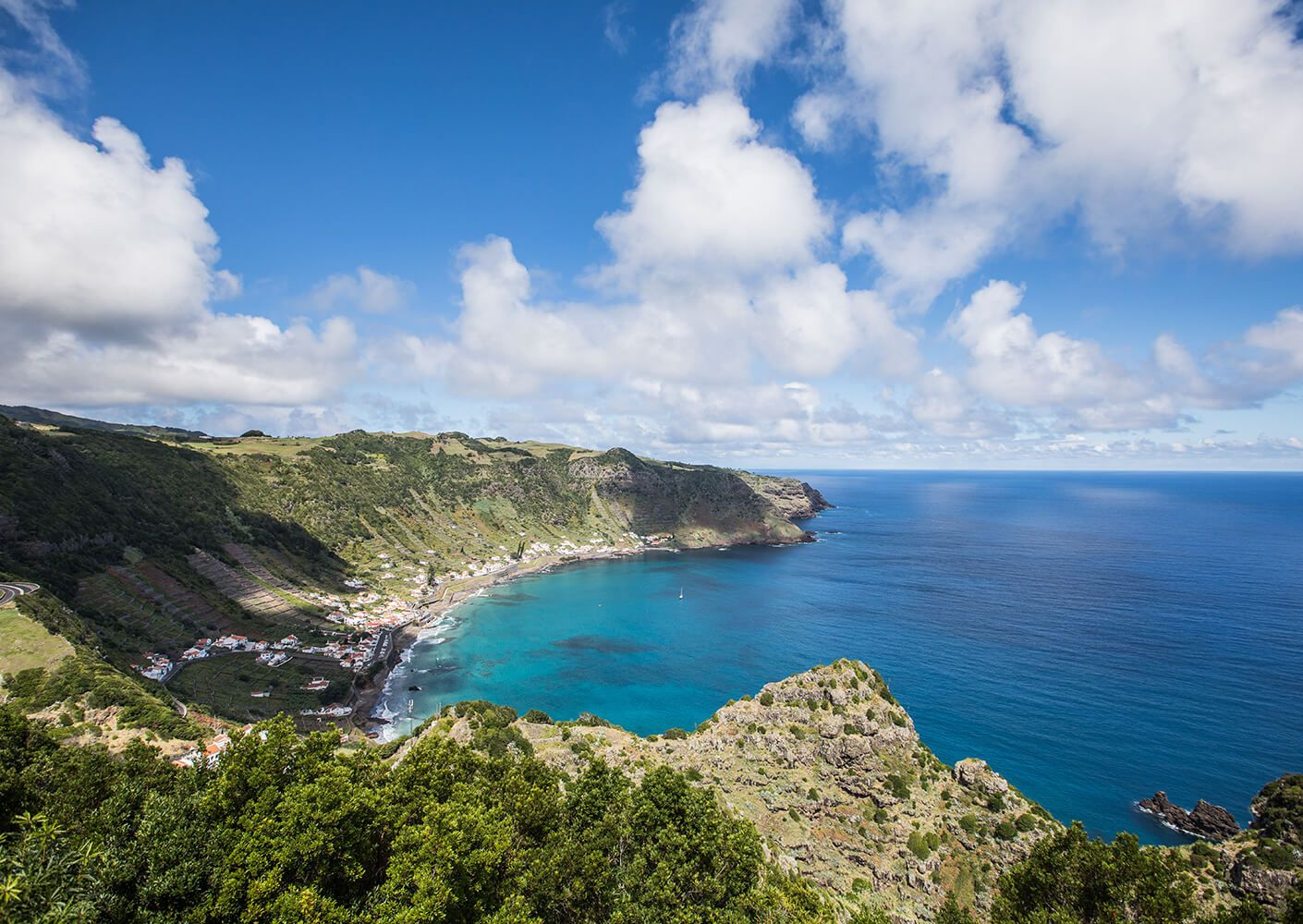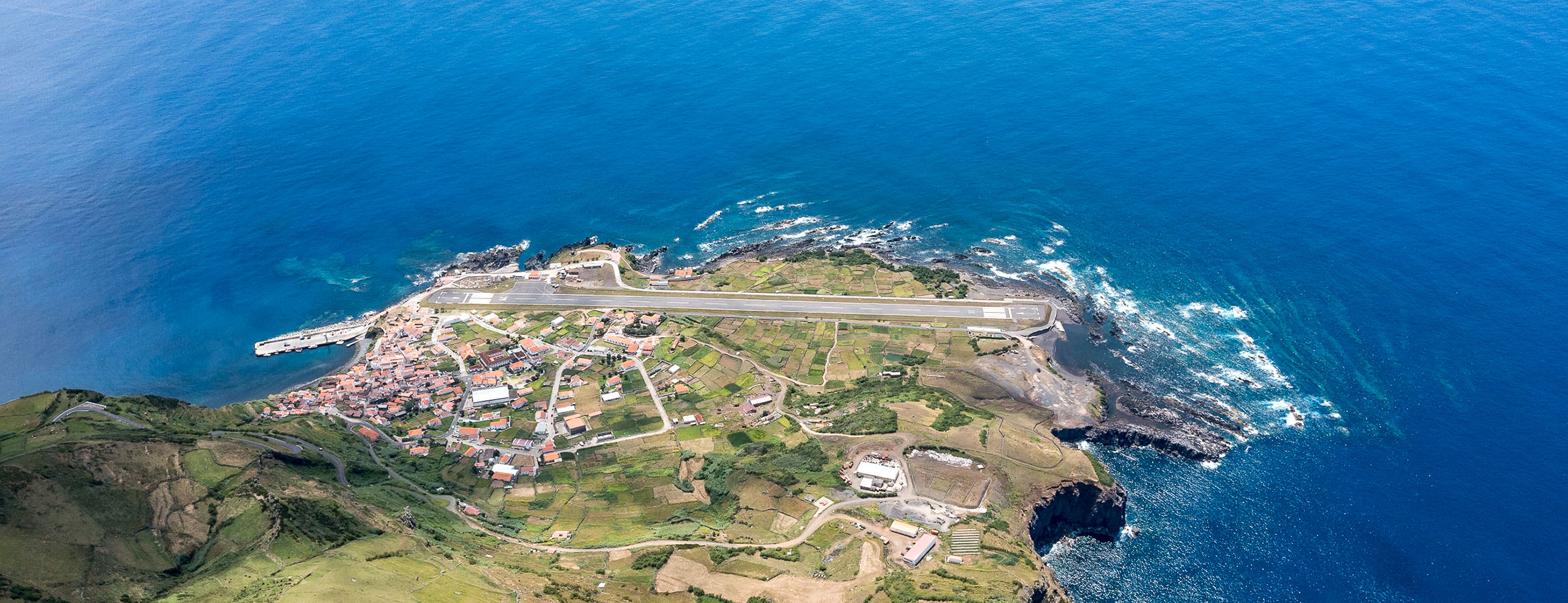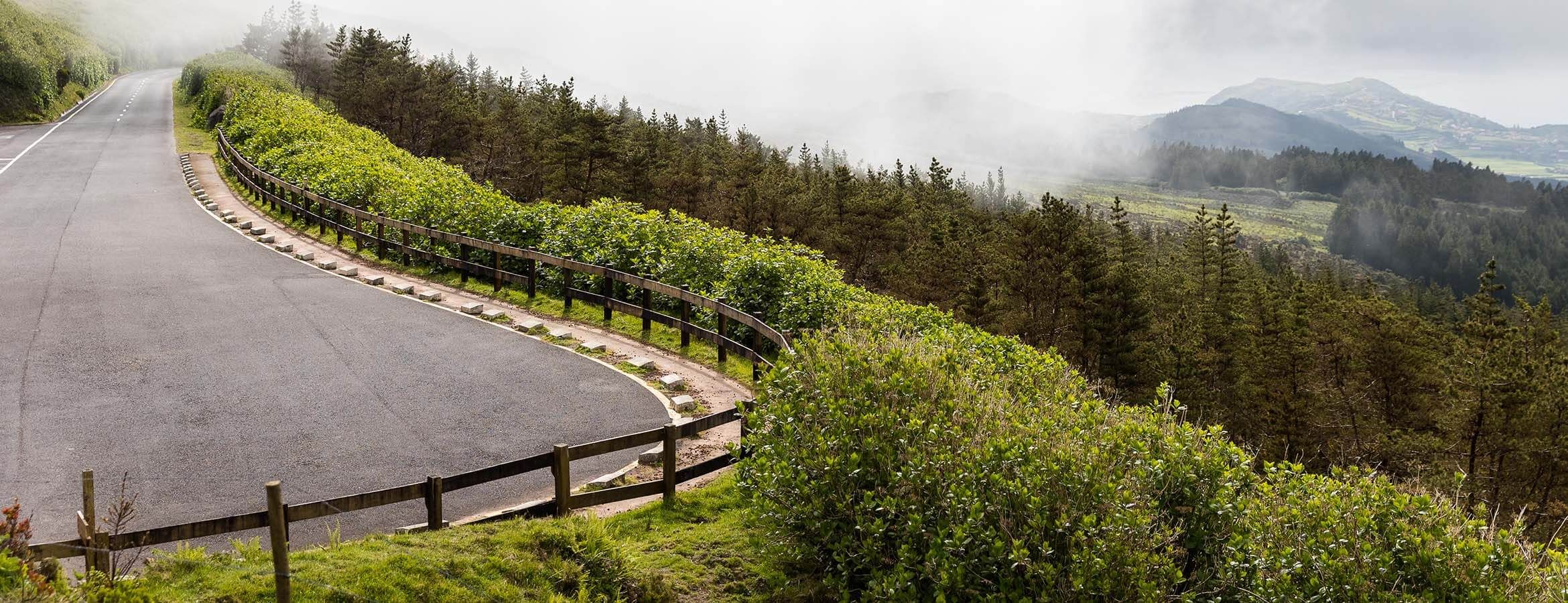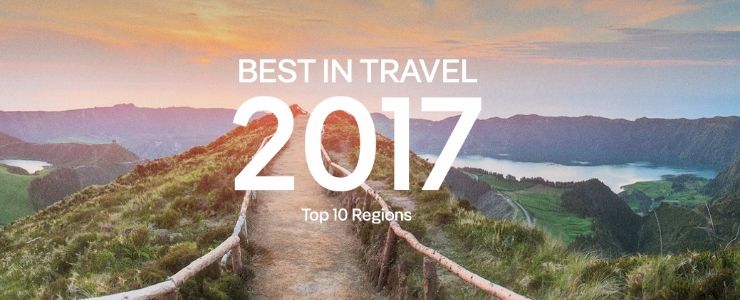

Santa Maria
With 16.6 km of length, 9.1 km at its maximum width and a total area of 97 km2, the island of Santa Maria has 5,552 inhabitants (2011 data)
With 16.6 km of length, 9.1 km at its maximum width and a total area of 97 km2, the island of Santa Maria has 5,552 inhabitants (2011 data). Together with the island of São Miguel, it forms the Eastern Group of the Azores Archipelago, with the two islands distancing 81 km from each other. Pico Alto, the island’s highest point, reaches an altitude of 587 m and is located at 36º58’59’’ latitude north and 25º05’26’’ longitude west.
Some say that Diogo de Silves was the first Portuguese who had contact with this island, probably in 1427. Others defend the name of Gonçalo Velho Cabral, navigator and a friar of the Order of Christ, as the first to see this island in 1431. What is almost certain is that Santa Maria was the first point of contact with the Azores Archipelago, and the first effort to settle it in approximately 1439, at a time when the Donatory Captain Gonçalo Velho and a group of colonisers moored their boats at Praia dos Lobos. The arrival of new families from mainland Portugal, mainly from the Algarve and Alentejo, largely contributed for its development. Actually, they did it in such a manner that the locality of Porto was the first to receive a town charter. The local economy was then based on the woad, a dye plant from which is extracted a blue dye used to color textiles in the distant Flanders; on the production of wheat, a staple food at the time; and on the extraction of clay, used for the production of pottery and roof tiles.
In 1493, the ships of Christopher Colombo arrived in Santa Maria, on the return trip of their first voyage to discover America. During the 16th and 17th centuries, there were more ferocious landings, since the island was successively pillaged by privateers from England, France, Turkey and by Arabs from North Africa. In 1616, the island was occupied by the Moors for almost a week. According to the legend, part of the population took refuge in the Santana Cave to escape the pillage, fires, kidnappings and torture. In 1675, Moorish pirates returned in force to the Bay of Anjos. And when they left, they took prisoners to be sold as slaves.
After the peak of exports for the textile industry, the 18th and 19th centuries were marked by the spread of the culture of vineyards, wheat, corn, fruit orchards, potatoes and taro root, simultaneously with cattle breeding and dairies. Although this was a calmer period, part of the population decided to emigrate. The 20th century brought another progress and dynamism due to the construction of the airport. The work began in 1944, and it required thousands of American and Azorean labouring hands. The infrastructure was considered strategic for anti-submarine strategy during World War II, by the United States. After the war, the airport was no longer a military but a civil airport crucial for airplanes crossing the Atlantic Ocean. At the end of the sixties, jet planes, now with more range, stopped landing at Santa Maria. However, the airport has kept its role as the main centre of air traffic control over the Atlantic. Nowadays, the service sector is the basis of the economy, followed by agricultural, cattle breeding and fishing activities.
Since it is located further to south and to east, the island of Santa Maria has a warmer, drier climate with lower levels of rain, which contributes to the higher dryness of the land and vegetation, which is yellowish. Santa Maria is also known as the Island of the Sun.
The island features two areas with completely different characteristics: a flatter area at a lower altitude to the west, where the airport and the town of Vila do Porto are located, and a hilly area on the eastern half of the island, featuring more luxuriant vegetation and comprising the Pico Alto, which offers a good panoramic view.
The first island discovered and the first to be settled, Santa Maria was also the first island to be formed, emerging about 10 million years ago from the surrounding seafloor. Its age and diversified geological past are the basis of the unique geological and landscape features that the island has to offer.
Thousands of years have passed and the indelible but persistent and inexorable action of time caused rocks alteration and emergence of new lands on the island Santa Maria. Among these, the barreiros (clay terrains) of Santa Maria stand out, with their colour ranges from reddish to bright orange and an arid look and clayey nature, as they were moulded under weather conditions that are very different from what exists today on the island and in the Azores. The Barreiro da Faneca, known as the "Red Desert", enchants visitors with its undulating, smooth surface with different colours depending on the time of day.
At the Poço da Pedreira, carved in the Pico Vermelho the colour of the island remains unchanged. And at this former quarry, nature gave man a hand and allowed the emergence of a pond at the base of the old extraction zone, creating a unique landscape that witness the self-healing role of nature.
At the Cabrestantes Bay, there is a small outcrop of yellowish underwater volcanic tuff whose true greatness one cannot anticipate; it is the oldest geological formation of Santa Maria and of the whole archipelago.
The singularity of the volcanic forms is particularly impressive at the waterfall of Ribeira do Maloás, where a columnar basalt disjunction is on display to visitors. The long, high wall of "lava sticks" is reminiscent of the Giant’s Causeway and invites us for a contemplative pause.
At the Cascata do Aveiro, an impressive 110 meters high waterfall, or at the Ponta do Castelo, with its towering Goncalo Velho Lighthouse as a sentinel, the feeling is the same: the extraordinary scenery.
As the oldest island of the Azores, Santa Maria showcases in its volcanic and sedimentary rocks the various oscillations of sea level that have occurred since the beginning of the Atlantic Ocean. This can be observed in the Pedreira do Campo, where a basalt flow formed under the ocean and limestone featuring numerous fossils of marine organisms (such as shells, corals and algae) bear witness to the geological reality of the island from about five million years ago.
In several other places of the island, sedimentary rocks preserve the fossils of many marine organisms that once inhabited the seas around Santa Maria; shark teeth, sponges, sea urchins, several types of shells and even bones of cetaceans are among the fossils which can be admired at the Dalberto Pombo Environmental Interpretation Centre, in the heart of the historic centre of Vila do Porto.
The island’s jagged coastline with its high rocky headlands and wide bays with shining, crystalline and calm waters are a permanent invitation to discover and contemplate them. Such is the case at the Cré, Raposo and Tagarete Bays, among many others.
In São Lourenço, the natural beauty of its delicate bay, with the Romeiro Islet surgically located at one end, is complemented by the gracious human presence. The vineyards that meticulously climb uphill, the white houses near the sea, and the agricultural plots that divide the terrains complete one of the most captivating panoramic views of the Azores, which can be appreciated from near and afar, namely from the Espigão Viewpoint.
At the Formosa Beach, the sun shines intensely on its white sand fed by the whitish sedimentary rocks that integrate the slopes and that justify the epithet of "the clearest beach of the Azores". The long, narrow beach is guarded by the ruins of the São João Baptista Fort and marks the passage between the blue Atlantic and the green coastline that nestles the bay. Less exuberant, the small pebble beaches of Figueiral and Baía de Lobos and the sandy beaches of Praínha and Sul invite you for a moment of isolation.
The volcanic nature of the island shaped tidal pools in Maia and in Anjos, which feature excellent supporting infrastructures for those who enjoy sea bathing.
Some houses of Vila do Porto showcase traces from the early times of settlement, namely arched doors and widows with features from the Manueline style. The original building of the Nossa Senhora da Assunção Church, which was later rebuilt, is proof of what may have been the first church built on Azorean soil. At the São Brás Fort, the cannons pointed towards sea recall the times of pirate attacks.
The parish of Anjos is dominated by a statue of Christopher Columbus. As far as history goes, this navigator at the service of Castile attended a Mass celebrated in the Nossa Senhora dos Anjos Chapel. Thus the Genoese navigator fulfilled on Azorean soil the promise he made during an intense storm that endangered his fleet. Only the side arched door remains from the original architecture of the chapel.
Manual labour became more refined in Santo Espírito, where the Nossa Senhora da Purificação Church stands out for its curvy stone works. The baroque façade, in s formats, contrasts with the right geometry of the bell tower, where basalt and lime are mixed until they come to rest on a pyramid covered with tiles.
Various colours can also be seen on the traditional homes of Santa Maria, marked by a rectangular format with around chimney on top of an incomplete pyramid. Each place on the island adopts a different colour in order to create a contrast against the white masonry – blue, yellow, green and… red ochre (almagre), which is typical in Almagreira and is an earthy, reddish colour that was used to glass pottery.
In Ribeira Grande and Azenhas de Baixo, the story about the mills used to move grinding stones by the power generated by water is well know. The landscape is also marked by windmills, with their typical wood handles to which the spades were tied.
Although the production of pottery has virtually come to an end on the island, other works are still done on manual weaver's loom, supported by the local handicraft cooperative (Cooperativa de Artesanato de Santa Maria). Table cloths, flax shirts, bedspreads and wool jerseys are some of the pieces that are made by local artisans.
As on the other islands, the Holy Ghost Festivals entertain Santa Maria from April until the summer. But it is in August that the island is more colourful and animated. All starts with the Rally of Santa Maria, a traditional round in the regional championship.
By mid month August, there is the Nossa Senhora da Assunção Festival, the patron saint of the island. There are various activities in Vila do Porto, with religious events being held hand in hand with dancing, concerts and handicraft and gastronomic fairs.
The arrival of the Maré de Agosto Music Festival is the peak of this entertaining month. With an international prominence, this festival is dedicated to world music and attracts visitors from various locations, who come to listen to music during the night and to rest on the beach during the day.
The land provides for one of the tastier dishes of Santa Maria. The Turnip Broth is made with a local kind of turnip, small and dark in colour. Besides the turnip, some pork meat, farmhouse bacon, the local sausage called chouriço and sweet potatoes are also added to the water. The broth is poured into a dish containing slices of bread, and the rest of the ingredients are served in a separate tray.
As for sweets, there are many local recipes. Tigeladas are often served in restaurants; however, light crisp cakes (cavacas), meringues, honey-cakes and cinnamon-based pastries are more typical, along with the biscoitos de orelha (ear biscuits), so called due to their shape.
Rockmelons grown on the island have attained fame and a gourmet status over time. As for the handmade sausages, the highlight goes to the Alheira of Santa Maria.
This is an island with a wine tradition, although poorly practiced now, but there are still some families who produce local wine, mainly for domestic use, from the vineyards that grow in plots of land confined by grey stones. Other beverages, such as the aguardente and some liqueurs made from fruit, have also attained fame and tradition.














